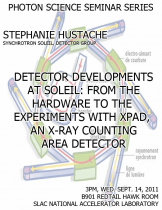Speaker: Stephanie Hustache, Synchrotron SOLEIL, Detector Group
Program Description
Soleil is the national French Synchrotron light source, which started users operation in 2008. The detector group, among other activities (electronics, beam monitoring…), has recently developed in collaboration with CNRS (Centre National de la Recherche Scientifique) a hybrid photon counting area detector named XPAD [1], which is particularly suited for hard X-ray scattering and imaging applications in biology, material science, cultural heritage…
This fast, noiseless and large dynamic range detector, comparable to Pilatus and Medipix which use the same type of technology, has open new possibilities for X ray Diffraction, Small and Wide Angle X-ray Scattering, scanning Differential Phase Contrast imaging… Besides these "classical" uses of this kind of detector, the deep knowledge of the hardware and the close collaboration with beamline scientists enabled us to develop new experimental methodologies.
After a brief presentation of Soleil, I will describe the detector characteristics and performances. I will show the results of three original experiments which take advantage of these unique performances: white beam energy resolved Laue diffraction; fast electric field switch diffraction experiment; chopper-less pump probe experiments down to the ns, and potentially to the 100 fs scale.
[1] K. STEPDMedjoubi et al., Journal of Synchrotron Radiation (2010). 17





